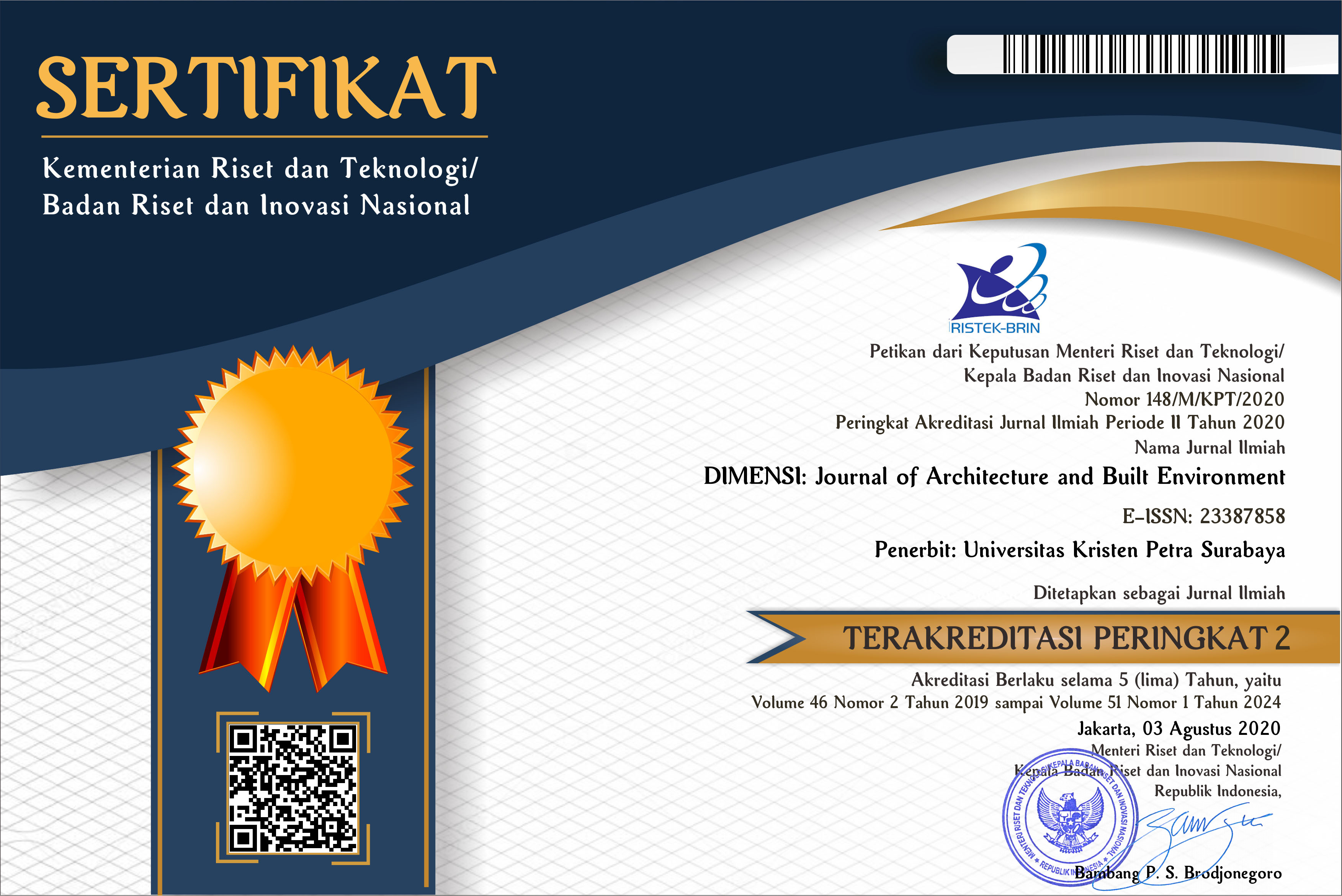THE INFLUENCE OF WALL COLOR AND LAMP COLOR TEMPERATURE TO STUDENT’S CONCENTRATION AND COGNITION
 :
:
https://doi.org/10.9744/dimensi.43.1.15-22
Keywords:
Concentration, color, lamp color temperatureAbstract
Concentration has an important role in our life, especially in order to get a quality and productivity in working. With concentration we can achieve the maximum and faster result in our work. Some ways to improve concentration that being researched here is by arranging the wall color and the lamp color temperature of the room. The color used as wall color in this research was the blue 9.8B, 7.4/5.6; and the orange 8.1YR, 8.7/3.7 of the Munsell color palette. Whereas the room lighting was the fluorescent lamp in 6500K (cool daylight) and 2700K (warm white) color temperature. Respondents of this research were 117 undergraduate students, the average GPA was 3.28; and 20,26 years as the mean age. The concentration and cognition tests are the Army Alfa test and IST subtest 9 that conducted in the room with different condition. Found in this research that the blue with cool daylight lamp has significant impact to concentration in 2,526 Lickert scale; and that orange with cool daylight lamp has correlation 0.781 to cognition result; but the other conditions have no significancy toward concentration and cognitionDownloads
References
Aiken & Lewis, R. (2008). Pengetesan dan Pemeriksaan Psikologi. Jakarta: PT Indeks.
Ahmadi, A. (1992). Psikologi Umum. Jakarta: Rineka Cipta.
Anastasi, A. & Urbina, S. (2006). Tes Psikologi. Jakarta: PT. Indeks.
Chan, T.C. (1996). Environmental Impact on Student Learning, Valdosta State Coll., GA. School of Education.
Elliot, A.J. & Maier, M.A. (2007). Color and Psychological Functioning, Journal of Color Psychology, 16(5), Association for Psychological Science, accessed from http://www.psych. rochester.edu/research/apav/publications/documents/2007_ElliotMaier_ColorandPsyFunct.pdf
Erwine, B. & Heschong, L. (2002). Lighting for Learning. Paper presented at the Light fair International Seminar Preview.
Gaines, K.S. & Curry, Z.D. (2011). The Inclusive Classroom: The Effects of Color on Learning and Behavior, Journal of Family & Consumer Sciences Education, 29(1), Spring/Summer 2011.
Hidayat, S. & Kargenti, A. (2010). Pengaruh Musik Klasik Terhadap Daya Tahan Konsentrasi dalam Belajar. Jurnal Psikologi, p.164-176
Jago, E. & Tanner, K. (1999). Influence of the school facility on student achievement. Retrieved March, 3, 2011, from http://www.coe.uga.edu/ sdpl/researchabstracts/visual.html.
Jalil, N.A., Yunus, R.M. & Said, N.S. (2012). Environmental Colour Impact upon Human Behaviour: A Review, Procedia - Social and Behavioral Sciences, 35, p. 54–62.
Kopacz, Jeanne (2004). Color in Three Dimensional Design. McGraw-Hill Companies, USA.
Linschoten, J. & Mansyur (1983). Pengantar Ilmu Jiwa. Bandung: Jemmars.
Noble, E.L. & Arps, G.F. (1920). University Students' Intelligence Ratings According to the Army Alpha Test, The Journal of Philosophy, Psychology and Scientific Methods, 17(17), p.468-469, Accessed from: http://www.jstor.org/stable/ 2940640.
Phillips, D. (2000). Lighting Modern Buildings, Architectural Press, Oxford.Psychological Science, accessed from http://www.psych.rochester.edu/research/apav/publications/documents/2007_ElliotMaier_ColorandPsyFunct.pdf
Pulay, A. S. (2010). Awareness of Daylighting on Student Learning in an Educational Facility. University of Nebraska - Lincoln, Lincoln.
Rachman (2010). Teori Konsentrasi Belajar. Accessed from http://repository.upi/s_tb_055186_bab_ ii.pdf/. on 13 Juli 2015.
Samani, S.A. & Samani, S.A. (2012). The Impact of Indoor Lighting on Students’ Learning Performance in Learning Environments: A knowledge internalization perspective International Journal of Business and Social Science, 3(24) [Special Issue – December 2012].
Santrock, J.W. (2003). Adolescence. Jakarta: Erlangga.
Singh, S. (2006). Impact of color on marketing, Journal of Management Decision, 44(6), p.783-789, Emerald Group Publishing Limited
Luscher, M. (1969). The Luscher color test. Random House, New York
Slameto (2003). Belajar dan Faktor Faktor yang Mempengaruhinya. Jakarta: Rineka Cipta.
Surya, H. (2009). Menjadi Manusia Pembelajar. Jakarta: Elex Media Komputindo.
Tabrani, H. (1995). Rahasia Sukses Belajar. Jakarta: Raja Grafindo Persada.
Veitch, J. A. (2001). Psychological processes influencing lighting quality. Journal of the Illuminating Engineering Society, 30(1), p.124-140.
Downloads
Published
How to Cite
Issue
Section
License
Authors who publish with this journal agree to the following terms:
- Authors retain copyright and grant the journal right of first publication with the work simultaneously licensed under a Creative Commons Attribution License that allows others to share the work with an acknowledgement of the work's authorship and initial publication in this journal.
- Authors are able to enter into separate, additional contractual arrangements for the non-exclusive distribution of the journal's published version of the work (e.g., post it to an institutional repository or publish it in a book), with an acknowledgement of its initial publication in this journal.
- Authors are permitted and encouraged to post their work online (e.g., in institutional repositories or on their website) prior to and during the submission process, as it can lead to productive exchanges, as well as earlier and greater citation of published work (See The Effect of Open Access).


















